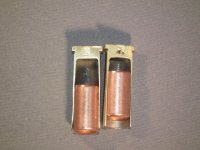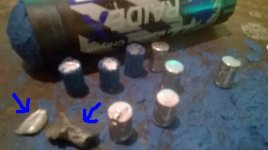TheGuyOfSouthamerica
Moderator
Hi,
I just chronoed the Lee Tumble Lube 148 grain Wadcutter .358" and I got 1010 fps. It is Lees propietary lube groove design with many small grooves.
Here the Chronograph data (I managed to get working the APP but the Format is somewhat meager):
As you can see this TL design did have an velocity of 1010 fps and the 148 grain TL Wadcutter was loaded with 4.0 grains of powder. The energy it had was 335 fps.
This bullet loaded very easy and is very Slick.
The case is on the edge to get a bit more sticky but is LESS then with the Elmer Keith style bullets maybe due to reduced friction of the bullet and therefore a bit reduced pressure. The primer flattened but is Ok.
Like Picture below this bullet was loaded the same way.
For comparison...
The same bullet from Lee but with Elmer Keith style (traditional style) gave me 1001 fps of velocity as you can see in the following Picture (then the APP didn't work somehow) and 329 ft/lbs of energy:

Both rounds are loaded like this:

This round is seated with more difficulty and more force has to be applied to seat it.
Basically there is not that much of an difference in velocity. Both rounds have been loaded to exactly 4.0 grains of the same powder.
So maybe the design make the difference of 9 fps or any other variable can be the cause as well.
ADDENDUM
Here I post again other Chronograph data again for comparison
Other data according to the Chronograph
First Group is the Lee 148 grain lead Wadcutter (Elmer Keith syle lube grooves) and second Group is the bullet you see in the first Picture the Lee 124 Truncated Cone 9mm Luger lead bullet (Lee tumble lube design). All shot from the SAA 357 Magnum Revolver and loaded like in Pictures of this post.
148 grain Wadcutter Lee lead .358" bullet loaded with Saga 3.2 grain scavenged powder gives 860 fps of velocity. 243 ft/lbs
148 grain Wadcutter Lee lead .358" bullet loaded with J&G 3.1 grain scavenged powder gives 863 fps of velocity. 245 ft/lbs
148 grain Wadcutter Lee lead .358" bullet loaded with Orbea 3.0 grain scavenged powder gives 836 fps of velocity. 230 ft/lbs
148 grain Wadcutter Lee lead .358" bullet loaded with Saga 4.0 grain scavenged powder gives 1001 fps of velocity. 329 ft/lbs
124 grain TC Lee lead .356" bullet loaded with J&G 3.1 grain scavenged powder gives 892 fps of velocity. 219 ft/lbs
124 grain TC Lee lead .356" bullet loaded with Orbea 3.0 grain scavenged powder gives 871 fps of velocity. 209 ft/lbs
124 grain TC Lee lead .356" bullet loaded with Saga 3.1 grain scavenged powder gives 848 fps of velocity. 198 ft/lbs
I just chronoed the Lee Tumble Lube 148 grain Wadcutter .358" and I got 1010 fps. It is Lees propietary lube groove design with many small grooves.
Here the Chronograph data (I managed to get working the APP but the Format is somewhat meager):
Created: 05-02-2017 09:48:18 AM Description: 148 grain lee tumble lube Wadcutter Notes 1: Notes 2: Distance to Chrono (FT): 3.00 Ballistic Coefficient: 0.075 Bullet Weight (gr): 148.000 Altitude (FT): 400.0 Temp: N/A BP: N/A Shots # FPS FT-LBS PF 1 1010 335.29 149.48 Average: 0.00 StdDev: 0.00 Min: 1010 Max: 1010 Spread: 0 True MV: 0.00 Shots/sec: 0.00 Group Size (IN): 0.00
As you can see this TL design did have an velocity of 1010 fps and the 148 grain TL Wadcutter was loaded with 4.0 grains of powder. The energy it had was 335 fps.
This bullet loaded very easy and is very Slick.
The case is on the edge to get a bit more sticky but is LESS then with the Elmer Keith style bullets maybe due to reduced friction of the bullet and therefore a bit reduced pressure. The primer flattened but is Ok.
Like Picture below this bullet was loaded the same way.
For comparison...
The same bullet from Lee but with Elmer Keith style (traditional style) gave me 1001 fps of velocity as you can see in the following Picture (then the APP didn't work somehow) and 329 ft/lbs of energy:
Both rounds are loaded like this:
This round is seated with more difficulty and more force has to be applied to seat it.
Basically there is not that much of an difference in velocity. Both rounds have been loaded to exactly 4.0 grains of the same powder.
So maybe the design make the difference of 9 fps or any other variable can be the cause as well.
ADDENDUM
Here I post again other Chronograph data again for comparison
Other data according to the Chronograph
First Group is the Lee 148 grain lead Wadcutter (Elmer Keith syle lube grooves) and second Group is the bullet you see in the first Picture the Lee 124 Truncated Cone 9mm Luger lead bullet (Lee tumble lube design). All shot from the SAA 357 Magnum Revolver and loaded like in Pictures of this post.
148 grain Wadcutter Lee lead .358" bullet loaded with Saga 3.2 grain scavenged powder gives 860 fps of velocity. 243 ft/lbs
148 grain Wadcutter Lee lead .358" bullet loaded with J&G 3.1 grain scavenged powder gives 863 fps of velocity. 245 ft/lbs
148 grain Wadcutter Lee lead .358" bullet loaded with Orbea 3.0 grain scavenged powder gives 836 fps of velocity. 230 ft/lbs
148 grain Wadcutter Lee lead .358" bullet loaded with Saga 4.0 grain scavenged powder gives 1001 fps of velocity. 329 ft/lbs
124 grain TC Lee lead .356" bullet loaded with J&G 3.1 grain scavenged powder gives 892 fps of velocity. 219 ft/lbs
124 grain TC Lee lead .356" bullet loaded with Orbea 3.0 grain scavenged powder gives 871 fps of velocity. 209 ft/lbs
124 grain TC Lee lead .356" bullet loaded with Saga 3.1 grain scavenged powder gives 848 fps of velocity. 198 ft/lbs
Last edited:


